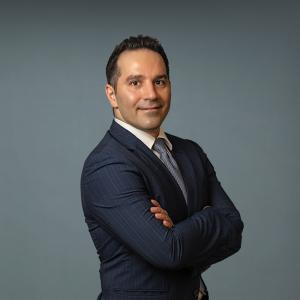
A T cell (orange), a type of white blood cell that helps the immune system fight infections, attaches to a cancer cell (blue). When blood cancer remains active, even after chemotherapy, a patient’s own T cells can be harvested, reengineered, and infused into the patient.
Credit: ROGER HARRIS / SCIENCE PHOTO LIBRARY / Getty
Nearly 188,000 people in the United States each year are diagnosed with a blood-borne cancer, such as leukemia, lymphoma, or myeloma. While these cancers are different in origin, they each arise from white blood cells that go awry. The standard of care for these malignancies typically includes stem cell transplantation, a procedure that involves replacing or reconstituting an individual’s bone marrow, the tissue found inside the large bones where most immature stem cells reside. Stem cells can develop into any type of white blood cell, red blood cell, or platelet. New stem cells divide again and again, creating healthy blood cells that replace dysfunctional or diseased bone marrow and, oftentimes, help the immune system mount an attack against a tumor.
Enter NYU Langone Health’s Blood and Marrow Transplantation and Cellular Therapy Center, which performs an average of 150 transplants and cellular therapy treatments annually and has the best one-year posttransplant clinical outcomes of any institution in the tristate area. Mohammad Maher Abdul Hay, MD, the program’s director, and Anne Renteria, MD, the site director at NYU Langone Hospital—Long Island, both members of Perlmutter Cancer Center, explain how they and their colleagues achieve such outstanding results and why the program has established itself as a pioneer in the field.
Stem Cell Transplant Is a Kind of Rebirth
There are two primary types of stem cell transplants, and the procedure selected for a patient is determined by the form of blood cancer being treated. In autologous transplants, commonly used to treat myeloma and several forms of lymphoma, a patient’s own stem cells are harvested and frozen until they are ready to be reinfused following chemotherapy. The multistage process is necessary because the therapies that wipe out cancer cells also obliterate stem cells. For allogeneic transplants, commonly used to treat acute myeloid leukemia and other forms of the disease, a patient receives stem cells from a healthy donor following chemotherapy. Allogeneic transplants are more complex because the donor’s stem cells must be of a compatible tissue type to ensure that they don’t attack the recipient’s body, a potentially life-threatening complication known as graft-versus-host disease (GVHD).
“When a patient gets a transplant—the donor’s stem cell infusion—we call it ‘Day Zero’ because it’s as if they were just born,” says Dr. Abdul Hay. “Once someone’s immune system is replaced, they typically lose all the immunity they’ve acquired throughout their life.”
A Match Doesn’t Have to Be Perfect
Transplants are most successful when the recipient and donor share the same proteins that make up a person’s tissue type, known as human leukocyte antigen (HLA) markers. Well-matched recipients are less likely to develop GVHD, graft rejection, a weak immune system, and serious infections. However, because there are thousands of possible combinations of HLA tissue types, finding an ideal match can be challenging. HLA markers are inherited from both parents, so the search for a donor starts with the patient’s siblings, who each have about a one-in-four chance of being a full match.
If none is identified, the search moves on to parents, half siblings, and grandchildren, though these are half matches at best. For patients without a fully matched family member, the pool of prospective donors can be greatly enlarged by choosing a half-matched, or haploidentical, transplantation. Because nearly everyone has at least one half matched relative—a biological parent, sibling, or child—haploidentical transplants offer a shorter wait time for a transplant, particularly beneficial for patients with aggressive leukemias and lymphomas. Plus, new medications now enable half-matched donors to achieve results nearly comparable to fully matched ones. “The younger the donor, the better the outcome,” Dr. Abdul Hay explains. “Given a choice between a 20-year-old donor who is a half match and a 60-year-old donor who is a full match, we would opt for the younger donor.”
Our Doctors Have Pioneered a Protocol for Preventing Complications
GVHD, a syndrome that affects up to 50 percent of allogeneic transplant patients at different grades, can cause skin rashes, liver damage, and inflammation of the intestinal tract, among other maladies. Dr. Renteria explains it this way: “When a donor’s T cells, a type of lymphocyte, are transplanted into a recipient, they look around and say, ‘Wait a minute, this home is not mine. I can’t recognize a lot of things here, so I’ll attack everything I find that I don’t recognize.’” The challenge, she notes, is to mitigate GVHD risk without adversely impacting the patient’s new immune system from being able to recognize and eliminate cancer cells.
NYU Langone has pioneered a method for avoiding severe episodes of GVHD through a novel combination of medications. One drug, cyclophosphamide, is a strong type of chemotherapy that selectively kills replicating T cells, active in causing GVHD. Another, abatacept, is a modified antibody that prevents the activation of T cells, the immune system’s primary killer of infected and diseased cells. In 2024, NYU Langone had no high-grade cases of acute GVHD, compared to the national average of 20 percent.
The Body’s Immune System Can Be Taught to Fight Blood Cancer
When a patient with blood cancer is in complete remission, an allogeneic stem cell transplant can prevent the disease from ever returning. But when the disease remains active, even after chemotherapy, a transplant won’t be as effective. In such instances, our hematologic oncologists turn to a novel source of immunotherapy: the patient’s own T cells. Once harvested, they are engineered to express a chimeric antigen receptor (CAR) that, once infused into the patient, allows them to recognize and bind to specific proteins on the surface of the cancer cells, launching a seek-and-destroy mission. While a vast majority of patients given CAR T-cell therapy achieve remission within the first year, it may not be sustainable over the long term. Still, studies have shown that for some people with very advanced cancer, the treatment can eradicate their disease for many years, and advances in CAR T-cell technology are expected to improve outcomes. “CAR T-cell therapy is the future of cancer therapy,” says Dr. Abdul Hay, “and NYU Langone is leading the way with a robust portfolio of 20 clinical trials for CAR T-cell therapy that hold promise for blood cancers and solid organ tumors.”
Stem Cell Transplantation Takes a Village
Until their new immune system takes hold—about three weeks after transplant for a minimal measure of protection and about two years later for a fully established immune system—patients who receive a stem cell transplant are at high risk for illness. “During the first few months, we’re meticulous about shielding them from infections,” Dr. Abdul Hay explains. “They haven’t yet developed a fully competent immune system, so they are administered prophylactic antibiotics, antifungal, and antiviral medications.” Patients are assigned to a private hospital room, where visitors are limited and face masks are mandatory. They’re cared for by a large team of multidisciplinary and highly specialized professionals. After discharge, they’re counseled regarding nutritious diets that minimize the risk of infections, advised to avoid crowds, and scheduled for a series of vaccines when the time comes.
With a one-year survival rate of nearly 97 percent for patients who have had autologous transplants and above 80 percent for those who have had allogeneic ones, the Blood and Marrow Transplantation and Cellular Therapy Program at NYU Langone has earned accreditation in Manhattan and Long Island by the Foundation for the Accreditation of Cellular Therapy. “We have two locations, but we function as one program, even getting to know each other’s patients,” explains Dr. Abdul Hay. A third site, at NYU Langone Hospital—Brooklyn, is in the works to ensure that residents of the borough will no longer need to travel to Manhattan for a transplant. “We have great outcomes,” says Dr. Renteria, “because we’re meticulous about matching, have high-quality patient care enhanced by an outstanding nursing staff, maintain rigorous laboratory practices, and use innovative approaches to prevent and overcome posttransplant complications.”

